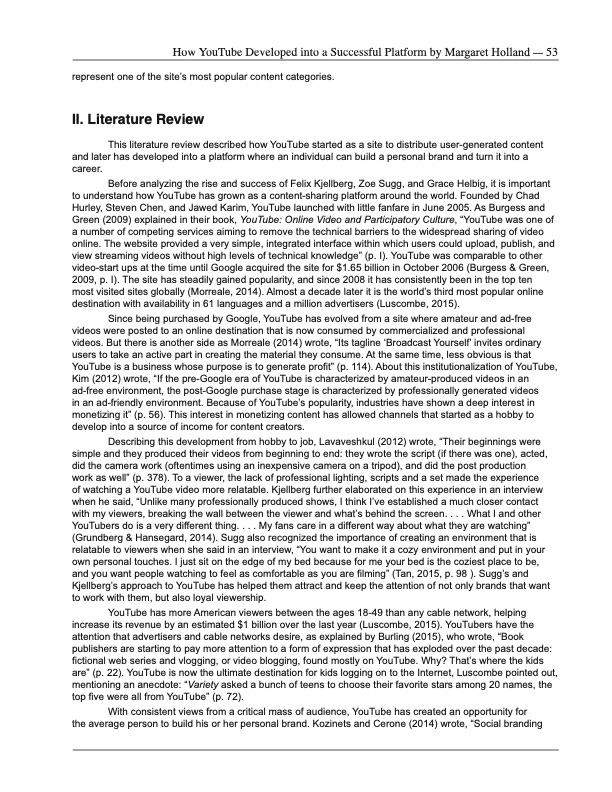
PDF Publication Title:
Text from PDF Page: 002
How YouTube Developed into a Successful Platform by Margaret Holland — 53 represent one of the site’s most popular content categories. II. Literature Review This literature review described how YouTube started as a site to distribute user-generated content and later has developed into a platform where an individual can build a personal brand and turn it into a career. Before analyzing the rise and success of Felix Kjellberg, Zoe Sugg, and Grace Helbig, it is important to understand how YouTube has grown as a content-sharing platform around the world. Founded by Chad Hurley, Steven Chen, and Jawed Karim, YouTube launched with little fanfare in June 2005. As Burgess and Green (2009) explained in their book, YouTube: Online Video and Participatory Culture, “YouTube was one of a number of competing services aiming to remove the technical barriers to the widespread sharing of video online. The website provided a very simple, integrated interface within which users could upload, publish, and view streaming videos without high levels of technical knowledge” (p. I). YouTube was comparable to other video-start ups at the time until Google acquired the site for $1.65 billion in October 2006 (Burgess & Green, 2009, p. I). The site has steadily gained popularity, and since 2008 it has consistently been in the top ten most visited sites globally (Morreale, 2014). Almost a decade later it is the world’s third most popular online destination with availability in 61 languages and a million advertisers (Luscombe, 2015). Since being purchased by Google, YouTube has evolved from a site where amateur and ad-free videos were posted to an online destination that is now consumed by commercialized and professional videos. But there is another side as Morreale (2014) wrote, “Its tagline ‘Broadcast Yourself’ invites ordinary users to take an active part in creating the material they consume. At the same time, less obvious is that YouTube is a business whose purpose is to generate profit” (p. 114). About this institutionalization of YouTube, Kim (2012) wrote, “If the pre-Google era of YouTube is characterized by amateur-produced videos in an ad-free environment, the post-Google purchase stage is characterized by professionally generated videos in an ad-friendly environment. Because of YouTube’s popularity, industries have shown a deep interest in monetizing it” (p. 56). This interest in monetizing content has allowed channels that started as a hobby to develop into a source of income for content creators. Describing this development from hobby to job, Lavaveshkul (2012) wrote, “Their beginnings were simple and they produced their videos from beginning to end: they wrote the script (if there was one), acted, did the camera work (oftentimes using an inexpensive camera on a tripod), and did the post production work as well” (p. 378). To a viewer, the lack of professional lighting, scripts and a set made the experience of watching a YouTube video more relatable. Kjellberg further elaborated on this experience in an interview when he said, “Unlike many professionally produced shows, I think I’ve established a much closer contact with my viewers, breaking the wall between the viewer and what’s behind the screen. . . . What I and other YouTubers do is a very different thing. . . . My fans care in a different way about what they are watching” (Grundberg & Hansegard, 2014). Sugg also recognized the importance of creating an environment that is relatable to viewers when she said in an interview, “You want to make it a cozy environment and put in your own personal touches. I just sit on the edge of my bed because for me your bed is the coziest place to be, and you want people watching to feel as comfortable as you are filming” (Tan, 2015, p. 98 ). Sugg’s and Kjellberg’s approach to YouTube has helped them attract and keep the attention of not only brands that want to work with them, but also loyal viewership. YouTube has more American viewers between the ages 18-49 than any cable network, helping increase its revenue by an estimated $1 billion over the last year (Luscombe, 2015). YouTubers have the attention that advertisers and cable networks desire, as explained by Burling (2015), who wrote, “Book publishers are starting to pay more attention to a form of expression that has exploded over the past decade: fictional web series and vlogging, or video blogging, found mostly on YouTube. Why? That’s where the kids are” (p. 22). YouTube is now the ultimate destination for kids logging on to the Internet, Luscombe pointed out, mentioning an anecdote: “Variety asked a bunch of teens to choose their favorite stars among 20 names, the top five were all from YouTube” (p. 72). With consistent views from a critical mass of audience, YouTube has created an opportunity for the average person to build his or her personal brand. Kozinets and Cerone (2014) wrote, “Social brandingPDF Image | How YouTube Developed into a Successful Platform for User-Generated Content

PDF Search Title:
How YouTube Developed into a Successful Platform for User-Generated ContentOriginal File Name Searched:
06_Margaret_Holland.pdfDIY PDF Search: Google It | Yahoo | Bing
Cruise Ship Reviews | Luxury Resort | Jet | Yacht | and Travel Tech More Info
Cruising Review Topics and Articles More Info
Software based on Filemaker for the travel industry More Info
The Burgenstock Resort: Reviews on CruisingReview website... More Info
Resort Reviews: World Class resorts... More Info
The Riffelalp Resort: Reviews on CruisingReview website... More Info
| CONTACT TEL: 608-238-6001 Email: greg@cruisingreview.com | RSS | AMP |